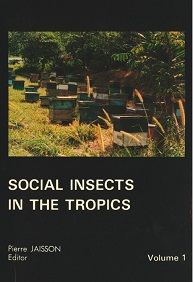

Social Insects in the Tropics
Symposium IUSSI et Société mexicaine d'entomologie, Pierre Jaisson, Cocoyoc, Mexique Novembre 1980
Publications Presses Université Paris Nord Volume 1 (1982) / Volume 2 (1983)
VOLUME I (1982)
- PREFACE P.
JAISSON
- PART I : CASTE DETERMINISM
1. Reproductive plasticity
in the neotropical Termite Nasutitermes corniger B.L. THORNE
2. Les
bases trophiques du déterminisme des castes chez les Trigones et Mélipones
B. DELAGE-DARCHEN, R. DARCHEN
3. Endocrine regulation
of caste determination in ants. L. PASSERA
- PART II : EVOLUTION OF SOCIAL BEHAVIOURS
4. Algunas consideraciones
sobre el origen y evolución de las sociedades de insectos. A. de
HARO
5. Eco-ethology and
evolution of social spiders. B. KRAFFT
6. Evolution of chemical
defenses in termites. G.D. PRESTWICH
7. The Nature
and Evolution of swarming in tropical social wasps (Vespidae, Polistinae,
Polybiini). M.J. WEST-EBERHARD
8. Evolution
of polyethism in ants : observational results and theories. D. FRESNEAU,
J. GARCIA PEREZ, P. JAISSON
9. Evolution
et rôle des communications antennaires chez les insectes sociaux.
A. LENOIR, P. JAISSON
10. The biology and behaviour
of the honeybee Apis florea. J.B. FREE
11. Plants
which supply «hair» material for nest building of Protopolybia sedula
(Saussure, 1854). V.L. LETIZIO MACHADO
12. Social parasitism
in Yellowjackets ( Vespula). R.W. MATTHEWS
- PART III : THE AFRICANIZED BEE
13. Introduction.
C.D. MICHENER
14. Population biology
of the africanized bee. G.W. OTIS
1 5. Comparación
del comportamiento recolector de abejas africanizadas y abejas europeas.
J.A. NUNEZ
16. Ecological impact
of africanized honeybees on native neotropical pollinators. D.W. ROUBIK
17. Behavioral genetic
analysis of colony-defense by honeybees. T.E. RINDERER
18. Effects
of brazilian climatic conditions upon the aggressiveness of africanized colonies
of honeybees. M. BRANDEBURGO, L.S. GONÇALVES, W.E. KERR
VOLUME 2 (1983)
- PART IV : INTERSPECIFIC RELATIONSHIPS AND PREDATION
19. Chemical
defense in termites : ecological aspects. H.R. COLES, P.E. HOWSE
20. Foraging strategies
and the structure of stingless bee communities in Costa Rica. L.K. JOHNSON
21. Comparative
foraging by neotropical army ants. C.W. RETTENMEYER, R. CHADAB-CREPET, M.G.
NAUMANN, L. MORALES
22. A behavioural study
of predation by Serrastruma serrula Santschi (Formicidae, Myrmicinae).
A. DEJEAN
23. Foraging and morphology
in ants : the role of Vertebrate predators as agents of natural selection.
J.H. HUNT
24. Interspecific trophallaxis
in ants, its ecological and evolutionary significance. A.P. BHATKAR
25. Quelques données
sur la biologie des fourmis Liometopum (Dolichoderinae) du Mexique
et en particulier sur leurs rapports avec les Homoptères. J. RAMOS
ELORDUY DE CONCONI, R. MAC GREGOR LOAEZA, J.I. CUADRIELLO AGUILAR, G. SAMPEDRO
ROSAS
- PART V : THE FUNGUS GROWING ANTS
26. Host plant
selection by an Attine ant. S.P. HUBBELL, D.F. WIEMER
27. The effects
of some ant species, especially Atta cephalotes L., Acromyrmex octospinosus
(Reich) and Azteca sp. (Hym. Form.) on citrus growing in Trinidad.
J.M. CHERRETT, A.T. JUTSUM
28. Chemical communication
systems in the ant Atta cephalotes. K. JAFFE
29. Leaf-cutting
ants (Atta sp.), damage to and distribution along Brazilian roads.
S.B. NOGUEIRA, M.R. MARTINHO
30. Diversidad
de especies de hormigas cortadoras y termitas de tumulo en cuanto a la sucesion
vegetal en praderas paraguayas. H.G. FOWLER, B.L. HAINES
- PART VI : IMPACT OF THE SOCIAL INSECTS ON THE TROPICAL TROPHIC
BIOSYSTEMS
31. Foraging oï
Macrotermes spp. (Isoptera : Macrotermitinae) in the tropics. M.G.
LEPAGE
32. The
effect of group size on the survival and feeding economy of pseudoworkers of
building damaging Cryptotermes spp. (Isoptera, Kalotermitidae).
R.M.C. WILLIAMS, J.V. PEREZ MORALES
33. Nitrogen fixation
in Nasutitermes in Central Amazonia. R. SYLVESTER-BRADLEY, L.A.
DE OLIVEIRA, A. GOMEZ BANDEIRA
34. Feeding strategies
of ants in different West African savannas. J. LEVIEUX